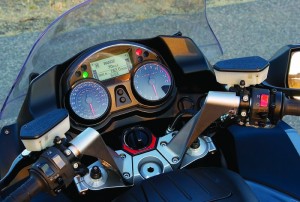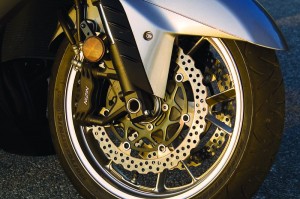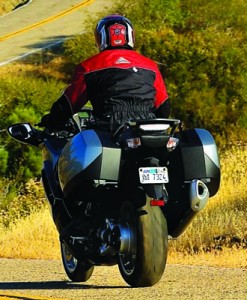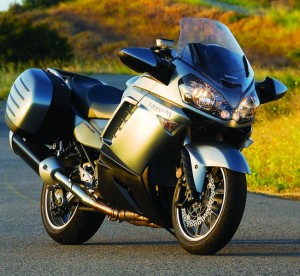It’s finally here! Twenty-one years since its introduction in 1986, Kawasaki has finally seen fit to reinvent the venerable Concours. Sure, it made a few refinements to the ZG1000 during those years, but the 2008 Concours 14–seen here with factory optional ABS–is an all new motorcycle based on the street shredding Kawsaki Ninja ZX-14 sportbike.
As such it’s got a decidedly sporty side, yet this is not just a ZX-14 with higher handlebars. The Concours 14 has been purpose-built for long-distance travel in comfort-it also just happens to have the handling, braking and cojones of Kawasaki’s largest kick-butt sportbike, nearly a liter-and-a-half in size.
Kawasaki used several innovations to better suit the ZX-14’s liquid-cooled, transverse, 1,352cc in-line four to touring without robbing it of too much top-end fire. As you might expect, the bores in the four throttle bodies have been narrowed from 44mm to 40mm for increased intake velocity and better low- and midrange throttle response. Ignition, fuel injection and exhaust were all refined for smoother power delivery, and Kawasaki went a step further by adding Variable Valve Timing, or VVT, which hydraulically advances or retards the intake cam in response to engine speed and throttle position. The dual gear-driven balancers and hydraulic cam-chain tensioners from the ZX-14 were retained, all of which results in a smooth, locomotivelike powerplant that pulls hard from a 2,500-rpm crawl all the way up to its redline of 10,500 rpm.

Kawasaki claims the revised engine makes 156 horsepower at the crankshaft at 8,800 rpm, and 103 lb-ft of torque at just 6,200. Even without the high-speed fans on the Borla Performance dyno required to take advantage of the Concours 14’s dual ram-air injection, it still cranked out 130 horsepower at 9,100 rpm at the rear wheel, and 87 lb-ft of torque at 7,600. At speed the ram air is probably good for another 4-6 horsepower. Though the shaft final drive (which the chain-drive ZX-14 doesn’t have) takes a share in frictional losses, even fully loaded and two-up with its load capacity of 425 pounds (our GVWR-less-wet-weight figure; Kawasaki says 441 pounds), a quick pass merely requires thinking about turning the throttle a little. Add a downshift and the Concours 14 simply flies around whatever is in front of you. Although you pay the price for all of this power in terms of average fuel economy (ours was just 36.5 mpg with a variety of riding styles and loads), the bike’s nicely sized 5.8-gallon tank gives it a range of more than 200 miles.
Up front the Concours wears a large concave radiator with dual fans (the ZX-14 has a single fan), and the four-two-one stainless-steel exhaust has a pair of catalyzers within. The EFI system on U.S. bikes is not closed-loop, as O2 sensors are not used. Like most fully faired, liquid-cooled motorcycles of this size, the Concours 14 rider feels quite a bit of heat on his or her lower legs when the ambient temperatures rise or the pace slows to a traffic-snarled crawl. The less insulation you’re wearing on your legs the easier it is to feel. We’ll have a comparison test in a future issue, but suffice to say the Concours’ heat output is certainly not as bad as the old Yamaha FJR1300, but probably worse than the new one.

Like the ZX-14 the Concours’ in-line four is mounted as a stressed member in a monocoque frame design, which connects a beefy pair of swingarm plates to the steering head with a thin-walled aluminum shell. A 43mm male-slider fork with adjustable spring preload and rebound damping guides the front wheel, while Kawasaki’s new Tetra-Lever swingarm is supported by a bottom-link spring strut with adjustable rebound damping and remotely adjustable spring preload. The Tetra-Lever is Kawasaki’s method of dealing with the problem of “shaft-jacking,” when throttle inputs cause the final drive pinion gear to climb up and down on the ring gear and load and unload the rear suspension. The Tetra-Lever’s dual-sided, four-link swingarm feeds those forces into the chassis rather than the suspension, preventing any effect on the ride as a result of getting on and off the throttle.
A ZX-14 rider will not recognize the Concours 14 from the cockpit. Handlebars are 3.8 inches farther back and nearly 6 inches higher, footpegs more than an inch lower and farther forward, and the seat a half-inch higher (and much cushier!). Up front is a well-designed electric windscreen, which Kawasaki says in terms of aerodynamics and visibility is designed for sport riding. It does indeed stay well below the rider’s line of sight at all times, yet I was pleasantly surprised by the still pocket of air it creates when all the way up, even shielding the tops of the rider’s legs. Up or down the shield can be noisy, with the least buffeting in the down position. Passengers reported that the increased warmth with it up was quite noticeable, but couldn’t detect any other difference between up or down. A taller windscreen is available as an accessory.
Passenger accommodations on the Concours 14 are first rate, with a wide, supportive, comfortable seat like the rider’s, good footpeg positions and excellent grabrails. My wife Genie said that she could ride back there all day without complaint. The grabrails are part of a rear rack system that helps support the side cases and LED taillight; it will carry 22 pounds in a duffle or the accessory top trunk on the rear platform. The locking, easily removed side cases are symmetrical and will each swallow a full-face helmet. There’s also a small glove box on the top of the fuel tank.
All-day comfort with a kind of always-ready-for-a-corner feel describes the Concours’ seating position. Mostly upright with just a slight amount of weight on the wrists, the comfortable seat lets you move around easily, and the windscreen can be used to increase warmth or cooling as well as take some weight off your wrists by increasing the windblast on your chest with a button push. It’s a fine ergonomic combination that is supremely comfortable (except perhaps for the heat at times) and instills confidence in attack mode. Passengers are neither too close nor too far away, and don’t slide around or bump your head, partly because it’s so easy to ride the bike smoothly. They’ve always got a good place to hang on, and there’s no abruptness or jerkiness from the EFI except for a tiny bit when cold (Kawasaki has used ECU-controlled sub-throttle valves to smooth throttle response).

At 693 pounds gassed-up and ready to ride with ABS (which Kawasaki says adds just 9 pounds), the Concours 14 ABS has 137 pounds on the Ninja ZX-14, and even 13-27 pounds on its ZG1000 predecessor, the Yamaha FJR1300A, and BMW K1200LT. You’d expect it wouldn’t lead a ZX-14 in the corners, what with the Concours 14’s wheelbase 2.4 inches longer and its rake and trail kicked out 3 degrees and a half-inch. But you might be surprised at how closely a skilled rider can stay on a sportbike’s tail. The bike steers quickly and easily-perhaps even at the sacrifice of a little highway stability at times-and unlike the FJR1300 never seems to run out of cornering clearance. The bike rides on grippy Bridgestone Battlax BT021 sport-touring rubber, and suspension quality and compliance are excellent. It’s definitely taut (this isn’t a luxury-touring bike and bumpy freeways and roads can get tiresome), but has superb damping and spring rates that soak up the bumps without obliterating them. I can’t wait to get it back-to-back with the Beemer and Yamaha.
Braking the Concours 14 is almost a no-brainer with its excellent binders front and rear-my only wish is for more range in the adjustable brake lever. Otherwise the bike stops hard and evenly with or without the ABS engaged, though I noticed that used alone the back brake felt a little wooden and pulses when the ABS kicks in. The front stops evenly without so much as a squeak from the tire, though, even hauled down from 60 mph when riding two-up. Kawasaki’s non-linked ABS system is well-suited to sportier riding, and at just 9 pounds is well worth the extra bit of weight.
Throw on a rudimentary instrument panel and Kawasaki could have stopped there and still have wowed the Concours fan. But it didn’t stop there. The Concours has a centerstand, of course, a good one, as well as an oil-level sight glass, a toolkit, good usable mirrors in folding shells, a powerful headlight and an easily accessed maintenance-free battery. Up on the instrument panel there’s an accessory outlet and headlight adjusters, and an analog tach and speedo flank an LCD info display with useful data such as current fuel economy, average fuel economy, miles remaining, etc. Let’s not forget the clock and gear position indicator, fuel gauge and dual tripmeters. Kawasaki is forgiven the omission of an ambient temperature thermometer by the addition of-drum roll, please-a tire-pressure display, fed to the LCD by sensors in the wheels. After the bike gets rolling, the sensors switch on (which preserves battery life) and produce a readout on the dash in psi, also warning if a pressure is too low. You can’t imagine the life-changing convenience such a thing offers both the daily and infrequent rider.

Signals from the tire sensors are received and processed by a secondary ECU on the Concours 14, which also controls the Smart Key system. Kawasaki’s Intelligent Proximity Activation Start System, or KIPASS, will not let the bike start-you can’t even turn the key in the ignition or remove it-unless a specially coded fob is within about 5 feet of the ignition switch. Carry the fob in your jacket pocket, for example, and when you’re done riding you park the bike, lock the steering and walk away, leaving the key in the bike if desired (there’s a spare in the fob). Unless the fob is close by, the key won’t turn or come out, and even if it were forced the bike won’t start. The fob is a transponder with a unique ID code; two are provided with every Concours 14, but up to six can be registered on its KIPASS ECU.
Should you start the bike, set the fob down nearby and ride off, a series of warning lights alert that you had better go back for your fob. Unlike a chipped key, by separating the key from the security chip-yet still requiring both to start the bike-Kawasaki has created another level of security for Concours 14 owners.
Stateside the Concours 14 will only be offered in the Neutron (we call it Hi-Yo) Silver you see here, although it’s also sold in black elsewhere, which may eventually come here as well. I wish it were a bit cooler, and that factory heated grips were available, but that’s my entire list of gripes. No need to wait for Kawasaki to get the bugs out of this one-there aren’t any. It’s ready to ride, fast and far.
Want more Kawasaki Concours 14?? Check out the 2010 Kawasaki Concours 14 Review by Greg Drevenstedt or Rider‘s 2008 Best of Class and Motorcycle of the Year featuring the Concours 14.








I’m looking at a used 2008 Concours at the moment. Thank you for this review.